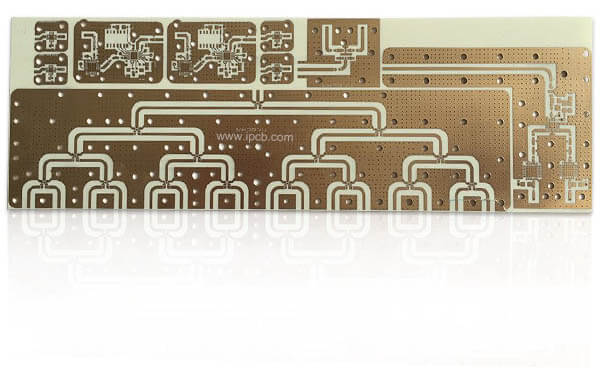High frequency PCB refers to a special PCB with high electromagnetic frequency, used in high-frequency (frequency greater than 300MHz or wavelength less than 1m) and microwave (frequency greater than 3GHz or wavelength less than 0.1M) fields. It is a PCB produced by using ordinary rigid PCB manufacturing methods or special processing methods on microwave PCB substrate copper-clad boards. Generally speaking, high-frequency PCB boards can be defined as PCB boards with frequencies above 1GHz.
With the rapid development of science and technology, more and more equipment are designed in the microwave frequency band (>1GHz) and even the millimeter wave field (30GHz). This also means that the frequency is getting higher and higher, and the requirements for PCB substrates are getting higher and higher. For example, PCB substrate materials need to have excellent electrical properties and good chemical stability. As the frequency of power signals increases, the loss requirements for the substrate are very small, so the importance of high frequency PCB becomes highlighted.
.
High frequency PCB
High-frequency PCB application fields
Mobile communication products and intelligent lighting systems
Power amplifier, low noise power amplifier, etc.
Passive components such as power splitters, couplers, duplexers, and filters
In the fields of automobile anti-collision systems, satellite systems and radio systems, high-frequency electronic equipment is a development trend.
Classification of high-frequency PCB
Powder ceramics filled with thermosetting materials
A. High frequency PCB board manufacturer:
Rogers 4350b/4003c
Arlon's 25N/25FR
Taconic’s TLG Series
B. Processing methods of high-frequency PCB boards:
The processing technology is similar to that of epoxy resin/glass woven cloth (FR4), but the sheet is brittle and easy to break. When drilling and punching holes, the service life of drill bits and tool tools will be reduced by 20%.
PTFE material
A: High frequency PCB board manufacturer
1. Rogers’ ro3000 series, RT series and TMM series
2. Arlon’s ad/AR series, isoclad series and cuclad series
3. Taconic’s RF series, TLX series and tly series
4. Taixing microwave F4b, f4bm, f4bk, tp-2
B: high-frequency PCB processing process
1. Cutting of high-frequency PCB boards: the protective film must be retained to prevent scratches and indentations
2. High frequency PCB board drilling:
2.1 Use a new drill bit (standard 130). The best one comes in one piece and in a bunch. Presser foot pressure 40psi
2.2 The aluminum plate is the cover plate, and then the PTFE plate is tightened with a 1mm melamine backing plate
2.3 After drilling, use an air gun to blow out the dust in the hole.
2.4 Use the most stable drilling rig and drilling parameters (basically, the smaller the hole, the faster the drilling speed; the smaller the chip load, the smaller the return speed)
Hole opening processing of high frequency PCB boards
Plasma treatment or naphthalene sodium activation treatment is beneficial to pore metallization
High frequency PCB board PTH copper plating
After micro-etching (the micro-etching rate has been controlled at 20 micro inches), the plate is fed from the oil cylinder after PTH drawing.
If necessary, the plate should be fed through a second PTH and from the intended drum
High frequency PCB solder mask
Pretreatment: Use pickling instead of mechanical grinding
After pretreatment of the baking pan (90℃, 30min), brush green oil and solidify
The baking pan is divided into three stages: 80°C, 100°C and 150°C for 30 minutes (if oil stains are found on the surface of the base material, rework can be carried out: wash off the green oil and reactivate it)
High frequency PCB board function board
Lay the white paper on the surface of the polytetrafluoroethylene board line, and clamp it with an FR-4 base plate or a 1.0mm thick phenolic base plate to remove copper: as shown in the figure:
The burrs on the backboard of the power board need to be carefully scraped off by hand to prevent damage to the base material and copper surface, and then separated by a certain size of sulfur-free paper and visually inspected. Reduce burrs. The key is that the gong plate removal process is more effective.
High frequency PCB process flow
Npth PTFE board processing technology
Cutting - drilling - dry film - inspection - etching - etching - soldering - characters - spray tin - forming - testing - final inspection - packaging - transportation
PTH’s PTFE plate processing process
Blanking and drilling treatment (plasma treatment or naphthalene sodium activation treatment) - copper plating - electroplating dry film - inspection - pattern electro-etching - corrosion inspection - solder mask - characters - spray tin - molding - testing - final inspection - packaging - Ship
Summary of high frequency PCB
Difficulties in processing high frequency PCB
1.Copper coating: The hole wall is not easy to be covered with copper
2.Line gap and sand hole control of pattern rotation, etching and line width
3.Green oil process: control green oil adhesion and green oil foaming
4.Strictly control board scratches in each process